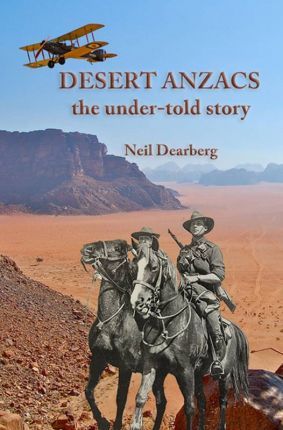The stories of the ANZACs at Gallipoli, and the Australian Corps on the Western Front are well known, but the story of the ANZACs who fought in Sinai and Palestine is not. Neil Dearberg, a former army officer and historian of the Sinai, Palestine and Arabian campaigns sets out to correct this ignorance in DESERT ANZACS, the under-told story.

Paperback 320pp RRP: $33.00
After the withdrawal from Gallipoli, the ANZACs returned to Egypt on their way to the Western Front, but Australian influence in London ensured that the Light Horse Division remained in Egypt as part of the Egyptian Expeditionary Force. This was a wise decision as the Australians and New Zealanders were mostly countrymen, used to riding in difficult and remote country and better suited to the desert than their English counterparts. Although some learned to ride camels (ANZACs formed almost half the Imperial Camel Corps), the Light Horse units rode large, strong Australian ‘Waler’ horses that, like the riders, could survive with limited water in the desert.
The desert ANZACs began to establish their reputation when a force attacked and defeated Turks building water cisterns at Jifjafa. The next success was the capture of Ramadi, by a force under Major General Chauvel, driving the Turks back to El Arish and removing the threat to the Suez Canal. The Allied advance into Palestine was now held up by the strong enemy position at Gaza, and after two costly attempts to capture it by direct assault had failed, 800 Light Horsemen under (now) Lieutenant General Chauvel carried Beersheeba by a cavalry charge and forced the enemy withdrawal from Gaza.
Rather than writing “a rambling description of one battle after another intended for academics and historians”, Dearberg writes about the ANZAC men and nurses, and their roles and recollections based on diaries, letters and photos. He has taken part in several archaeological expeditions along the Hejaz Railway in addition to his archival research and interviews, and his knowledge of the subject is obvious. The Arab Revolt in the Hejaz and the Arab advance into Jordan and Syria is well covered, as is the importance of the Australian Flying Corps to the success of the Allied advance.
The style is down-to-earth and incompetent generals are given short shrift. Expressions such as ‘Australia’s Government received the news like free beer at a wedding’ are initially surprising, but I soon found the book difficult to put down. The strategies of the ‘good guys’ (the Allies) and the ‘bad guys’ (the Turks and the Germans) are clearly described, as is the course of the desert war and the major battles. My only criticisms are that the maps are too small and there is no index.
Reviewed for RUSIV by Roger Buxton, August 2018
Contact Royal United Services Institute about this article.






